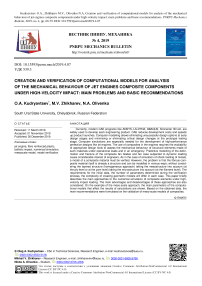Creation and verification of computational models for analysis of the mechanical behaviour of jet engines composite components under high-velocity impact: main problems and basic recommendations
Автор: Kudryavtsev O.A., Zhikharev M.V., Olivenko N.A.
Статья в выпуске: 4, 2019 года.
Бесплатный доступ
Currently, modern CAE programs like ANSYS, LS-DYNA, ABAQUS, Simcenter 3D etc. are widely used to develop each engineering product. CAE reduces development costs and speeds up product launches. Computer modelling allows eliminating unsuccessful design options at early design stages and minimising or eliminating critical design changes at the prototype testing stage. Computer simulations are especially needed for the development of high-performance perfection designs like jet engines. The use of composites in the engines requires the availability of appropriate design tools to assess the mechanical behaviour of structural elements made of such materials under operational loads and in an emergency. Predictive modelling of the deformation and fracture of the composite fan blades and fan case subjected to dynamic loading cause considerable interest of engineers. As in the case of simulation of shock loading of metals, a model of a composite material must be verified. However, the problem is that the fibrous composite material itself is already a structure and can be modelled in various ways: without considering the layered structure (homogeneous approach) taking the mesostructure into account (at the ply-level or at the yarn-level) taking the microstructure into account (at the filament level). The requirements for the initial data, the number of parameters determined during the verification process, the complexity of creating geometric models will differ in each case. This paper briefly describes the main approaches to the numerical simulation of composite elements under high-velocity impact loading. The main advantages and disadvantages of these approaches are also considered. On the example of the meso-scale approach, the main parameters of the computational models that affect the results of calculations are shown. Based on the obtained data, the main recommendations were formulated on the validation of meso-scale models of composites.
Jet engine, fibre reinforced plastic, ballistic impact, numerical simulation, mesoscale model, model verification
Короткий адрес: https://sciup.org/146281971
IDR: 146281971 | УДК: 539.3 | DOI: 10.15593/perm.mech/2019.4.07
Список литературы Creation and verification of computational models for analysis of the mechanical behaviour of jet engines composite components under high-velocity impact: main problems and basic recommendations
- Karelin O.O., Koltyrina К.Y. Employment of composite materials in aero-engine manufacturing. Bulletin of P.A. Solovyov Rybinsk State Aviation Technical University. 2015, no. 2 (35), pp. 53-59.
- Karimbaev T.D. CF composite fan rotor blading for perspective engines. engine. 2011, no. 6. pp. 1-6.
- Rubcov S.M. Primenenie sovremennyh polimernyh kompozicionnyh materialov v ehlementah i uzlah gazoturbinnyh aviacionnyh dvigatelej: dissertaciya na soiskanie uchenoj stepeni k.t.n: 05.02.01, Perm' 2009, 140p.
- Anoshkin A.N., Zuiko V.Yu., Shipunov G.S., Tretyakov A.A. Technologies and problems of composite materials mechanics for production of outlet guide vane for aircraft jet engine. PNRPU Mechanics Bulletin. 2014, no. 4, pp. 5-44. DOI: 10.15593/perm.mech/2014.4.01
- Grinev M.A., Anoshkin A.N., Pisarev P.V., Zuiko V.Yu., Shipunov G.S. CAD/CAE modelling of mechanical behavior of composite outlet guide vane for aircraft jet engine. PNRPU Mechanics Bulletin. 2015, no. 3, pр. 38-51. DOI: 10.15593/perm.mech/2015.3.04


